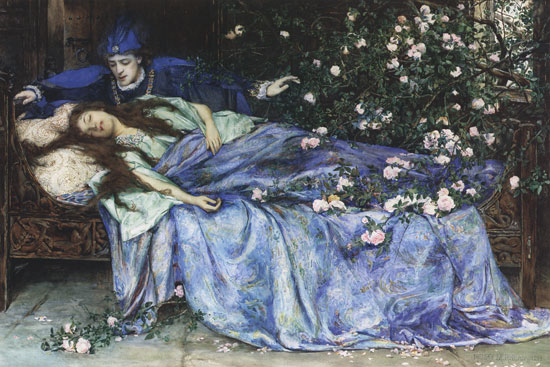Fairy
Tales
The perky, pretty little
blond, blue-eyed first grader
charmed Miss Konkle with her
quick answers
and love of alphabet,
stories, numbers. Charmed
too, Miss Brown, Mrs. Walter
and Mrs. Horton.
Caraboose, the bad fairy who put Princess Aurora
to sleep, along with the whole castle, was on the loose
doing a lazy fairy’s job: letting hormones destroy
the charming little girls -- many of them, perhaps most.
At twelve, the feet grew huge, arms hung gangling,
blond hair turned dishwater dull and drab, and a bean
pole body was slow to round out like the bodies of Barbies.
Myopia blurred the vision in the mirror; glasses were needed.
“Boys don’t make passes at girls who wear glasses.”
Oh, I knew, just when my brain matured enough to know
such things, that I was a mess. No dates for me, no boy
friends, none of those delicious teenage delights
in Seventeen. Teacher’s pet was a curse, excitement
about the Metropolitan Opera Saturday broadcasts instead
of Elvis or even Sinatra, part of the thorny hedge
the ugly fairy erected around me. I knew no Prince
would ever come to cut through the briars and kiss me
ever so gently -- oh, god, how I wanted that magic kiss!
Princesses in fairy tales don’t get to go to college.
I wasn’t born a princess and only Disney believes in fairies.
The good old Greyhound bus and the shot-straight roads
of Indiana took me to cities beyond the corn fields.
The mirror on the wall never did say I was “fairest of them all”
but I didn’t have to live with seven variously handicapped dwarfs.
I did have to wise up, forget about Princes and learn about Erica Jong
and Gloria Steinem. I looked down and saw those once gallumpy feet
were a very solid foundation for standing on.

"Sleeping Beauty", by Henry Meynell Rheam
Caraboose, or Carabosse, is the villain in the "Sleeping Beauty" fairy tale. (She is named Maleficent in the Walt Disney animated adaptation, which is the most familiar version). She is not named in the classic versions of the tale, Charles Perrault's "The Sleeping Beauty in the Wood" or the Brothers Grimm's "Little Briar Rose," and in fact her name comes from a similar character in a different fairy tale ("The Princess Mayblossom" by Madame d'Aulnoy, who coined the term fairy tale), but eventually the appellation was applied to the wicked fairy in "Sleeping Beauty," as in Pyotr Tchaikovsky's ballet. The story, of course, is about an adolescent girl cursed at birth to fall into a deathlike sleep until awakened by a kiss from her true love. (June also alludes to a similarly-themed Disney animation, "Snow White and the Seven Dwarves.") Despite the social conditioning of the poet's female teachers in elementary school, eventually she found a more realistic set of attitudes espoused by feminist writers such as Gloria Steinem and Erica Jong, thus rejecting the "wisdom' found in the common misquote of Dorothy Parker's short satirical poem, " News Item":
ReplyDeleteMen seldom make passes
At girls who wear glasses.